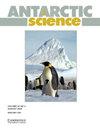智利的南极科学:2009-2019年期间科学生产力的文献计量分析
IF 2
4区 地球科学
Q3 ENVIRONMENTAL SCIENCES
引用次数: 1
摘要
摘要智利在2005年实施的南极科学发展战略的变化对智利南极科学计划(PROCIEN)的科学生产力产生了积极影响。我们分析了2009年至2019年间的科学计量指标。书目数据是使用搜索查询关键字从Web of Science数据库中提取的。我们使用了多重对应分析来确定具体趋势,并对VOSviewer的国际合作进行了网络分析。智利的南极科学出版物数量从2009年的21份逐渐增加到2019年的95份。在第一影响因子四分位数的期刊上,文章数量的增长更高。显示第一个四分位数影响因子论文增加的研究线与南极生态系统、生物技术和地球科学相对应。开展此类研究活动的主要地理区域对应于南设得兰群岛和南极半岛。实地调查数据是撰写科学文章的主要来源,这些论文大多集中在三个科学平台上。资金来源的多样化、选拔过程的改进以及智利与南极研究科学委员会方案的一致性,都有助于改进智利在南极发展的科学。本文章由计算机程序翻译,如有差异,请以英文原文为准。
Antarctic science in Chile: a bibliometric analysis of scientific productivity during the 2009–2019 period
Abstract The changes implemented in 2005 in the development strategies of Antarctic science carried out by Chile have had a positive impact on the scientific productivity of the Chilean Antarctic Science Program (PROCIEN). We analysed scientometric indicators from between 2009 and 2019. The bibliographic data were extracted from the Web of Science database using search query keywords. We used multiple correspondence analysis to identify specific trends and also network analyses of international collaboration in VOSviewer. The number of Antarctic science publications in Chile has gradually increased from 21 in 2009 to 95 in 2019. The rise in the number of articles was higher in journals for the first impact factor quartile. Research lines showing increased first-quartile impact factor papers corresponded to Antarctic ecosystems, biotechnology and geosciences. The main geographical domains in which such research activities have been carried out corresponded to in the South Shetland Islands and the Antarctic Peninsula. Fieldwork data are the main sources for the production of scientific articles, and there are three science platforms within which most of these papers concentrate. The diversification of funding sources, the implementation of improvements in the selection process and Chile's alignment with Scientific Committee on Antarctic Research programmes have contributed to improving the science that Chile has developed in Antarctica.
求助全文
通过发布文献求助,成功后即可免费获取论文全文。
去求助
来源期刊

Antarctic Science
地学-地球科学综合
CiteScore
3.60
自引率
6.20%
发文量
42
审稿时长
3 months
期刊介绍:
Antarctic Science provides a truly international forum for the broad spread of studies that increasingly characterise scientific research in the Antarctic. Whilst emphasising interdisciplinary work, the journal publishes papers from environmental management to biodiversity, from volcanoes to icebergs, and from oceanography to the upper atmosphere. No other journal covers such a wide range of Antarctic scientific studies. The journal attracts papers from all countries currently undertaking Antarctic research. It publishes both review and data papers with no limits on length, two-page short notes on technical developments and recent discoveries, and book reviews. These, together with an editorial discussing broader aspects of science, provide a rich and varied mixture of items to interest researchers in all areas of science. There are no page charges, or charges for colour, to authors publishing in the Journal. One issue each year is normally devoted to a specific theme or papers from a major meeting.
 求助内容:
求助内容: 应助结果提醒方式:
应助结果提醒方式:


